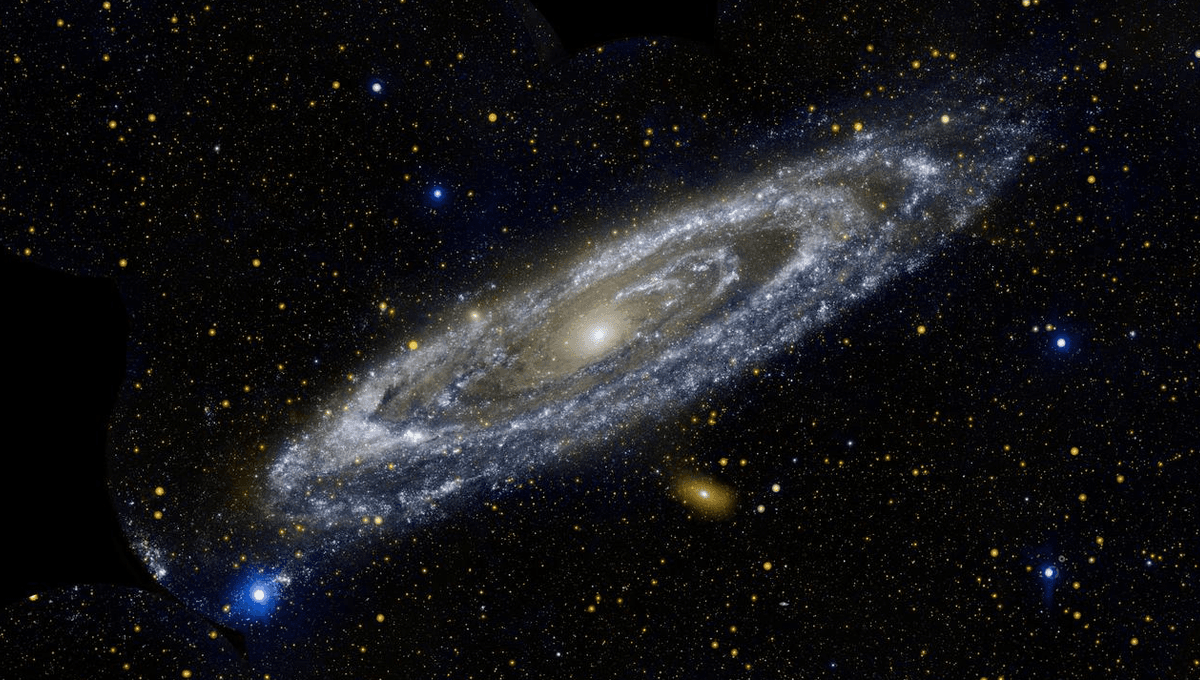
For every atom in the universe that makes up stars, planets, or gas, there is about more than five times as much so-called dark matter. Physicists are very confident it’s there, but cannot find it, or even work out what makes it up. We won’t know the exact reasons why it’s so hard to see until we answer the question of what dark matter is, but that doesn’t mean we know nothing at all.
How do we know dark matter is real?
The speed at which objects orbit each other depends on their distance, but also on their mass. We know how heavy the Sun is by observing how fast the Earth, and other planets, go around it. Things get more complex when the mass controlling the orbital speed is spread out, rather than at a single point, but physicists have got very good at solving those sorts of problems.
Consequently, when we look at the rates at which stars in nearby galaxies orbit, or the speed at which galaxies on the edge of giant galactic clusters are traveling, we know how much mass is causing that motion. However, when astronomers try to estimate the number of stars in those galaxies, and their average masses, the figures don’t match. The visible stars don’t provide nearly enough mass to match the effects they are having on objects at the edges. The estimates of stellar mass may be rough – we can’t count every star, but the discrepancy is far too large to be simple under-sampling.
A small minority of scientists explain this by arguing that gravity works differently at large scales from our models, which are based on the movements of planets and moons within the Solar System. One version of this idea has received a lot of publicity, but most physicists consider it improbable at best.
Almost certainly then there is something out there that has a lot of mass, enough to warp space-time in ways that affect the motions of everything else, but we can’t see: in other words, dark matter.
Gravitational lenses provide even more evidence. We see galaxies that are bending light from more distant objects, and they bend it a lot more than the visible stars can account for.
Once there was widespread agreement that dark matter existed, the quest was on to identify its nature. At that point, the only things we knew were that dark matter produces gravitational effects – i.e. that it has mass – and that it couldn’t be seen, at least with the instruments we had.
Why we can’t see it depends on what it is
Initially, two competing explanations were popular. One proposed dark matter was made up of large objects that emitted no light. They might reflect light if suitably positioned, but weren’t close enough to stars to be reflecting useful amounts. Astronomers imagined vast numbers of Jupiter-mass objects roaming the space between stars. These objects were referred to as Massive Compact Halo Objects (MACHOs), the halos here being those belonging to galaxies.
The primary alternative was subatomic particles, individually light, but existing in such unimaginable numbers that collectively they could provide the missing mass. In contrast to the MACHOs, these were named WIMPs (Weakly Interacting Massive Particles) with the massive here meaning “has mass”, not “enormous”, since they are anything but.
These examples make clear why there is no universal answer to the question “Why can’t we see dark matter?”. If dark matter is MACHOs, we can’t see it because we haven’t got close enough to this sort of object. If it’s WIMPs, seeing is impossible, but with the right sort of detecting device we may be able to confirm the particles’ existence.
The MACHO hypothesis is very much out of favor these days. A variety of indicators tell us that these sorts of objects make up a small proportion of the mass we are looking for, if any.
Without their opposite number WIMPs don’t get called that so much, but the possibility there are subatomic particles we don’t know about remains a live one. As time goes on, and more and more candidates for suitable particles are ruled out, the quest has become a little frustrating. Only once we find these particles, if we do, will we know what allowed them to elude us for so long.
There are some categories of subatomic particles that don’t fit under the WIMP umbrella, but might form dark matter, such as heavy neutrinos. Still, the answer is the same – only by determining which type of particle is responsible can we say why it was so hard to find.
There is much more to the search for dark matter than a MACHOs versus WIMPs smackdown. It’s been proposed that there are a lot more black holes in the outer reaches of galaxies than we know about. Famously, we can’t see black holes because their gravity is so powerful even light cannot escape. Technically these match the acronym to be MACHOs, but they’re considered something different.
We find black holes either by looking for the light from their accretion disks, or by watching the way they sling stars around them. In the outer parts of galaxies, where stars are few and material to form accretion disks is sparse, black holes could be abundant, and we’d never know. There are lots of problems explaining where these black holes might have come from, which is why the idea hasn’t proven as popular as some alternatives. Nevertheless, as other possibilities fall over, this is one that could come to the fore, providing its own explanation of why dark matter is hard to find.
Source Link: Why Can’t We See Dark Matter?